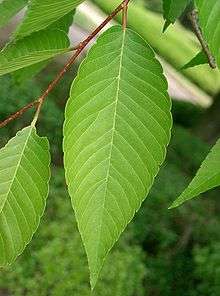Zelkova
| Zelkova | |
|---|---|
 | |
| Zelkova serrata | |
| Scientific classification | |
| Kingdom: | Plantae |
| (unranked): | Angiosperms |
| (unranked): | Eudicots |
| (unranked): | Rosids |
| Order: | Rosales |
| Family: | Ulmaceae |
| Genus: | Zelkova Spach |
Zelkova is a genus of six species of deciduous trees in the elm family Ulmaceae, native to southern Europe, and southwest and eastern Asia. They vary in size from shrubs (Z. sicula) to large trees up to 35 m (115 ft) tall (Z. carpinifolia). The leaves are alternate, with serrated margins, and (unlike the related elms) a symmetrical base to the leaf blade. The fruit is a dry, nut-like drupe, produced singly in the leaf axils.[1][2][3][4]
Species and distribution
- Zelkova abelicea—Cretan Zelkova (Crete in Greece)
- Zelkova carpinifolia—Caucasian Zelkova (Turkey, Georgia, Armenia, Azerbaijan, Iran)
- Zelkova serrata—Keyaki or Japanese Zelkova (Japan, Korea, Kuril Islands in Russia, Taiwan, China)
- Zelkova serrata var. serrata
- Zelkova serrata var. tarokoensis
- Zelkova sicula—Sicilian Zelkova (Sicily in Italy)
- Zelkova sinica—Chinese Zelkova (China)
- Zelkova schneideriana—Schneider's Zelkova (China)
- Hybrids
- Zelkova × verschaffeltii—Cut-leaf Zelkova (Z. carpinifolia × Z. serrata)
Ecology
The genus Zelkova was common throughout northern Europe and North America as late as the Pliocene. However, extensive Pleistocene glaciation has confined the genus to its present range to the eastern Mediterranean islands and the Caucasus, and in eastern Asia where only local glaciation occurred.[5][6]

The Sicilian Zelkova Z. sicula, only discovered in 1991, is listed as an endangered species. The only known population comprises a small number of low shrubs suffering from severe overgrazing; the natural mature size of undamaged specimens is unknown.[7]
Whilst all the known Zelkova taxa are currently in cultivation and in botanic gardens or arboreta, relatively few collections are known to be from wild sourced material or known in the countries of their natural distribution. Z. sicula and Z. abelicea are the two taxa considered to be at most risk of extinction (Critically Endangered and Vulnerable). These two Zelkova species are the two with the most restricted natural distribution—both are small island endemics. The Zelkova with the widest natural distribution, Z. serrata, is also the most common Zelkova in botanic garden collections [8]
Cultivation and uses
Zelkova serrata and Z. carpinifolia are grown as ornamental trees. The wood is hard, used for making furniture.
Etymology
The name Zelkova derives from the native name of Z. carpinifolia in one of the Kartvelian languages, as shown by the Georgian name, ძელქვა (dzelkva). ძელ dzel meaning "bar", and ქვა kva meaning "rock". The tree was often used for making rock-hard and durable bars for building.
References
- ↑ Andrews, S. (1994). Tree of the year: Zelkova. Int. Dendrol. Soc. Yearbook 1993: 11-30.
- ↑ de Spoelberch, P. (1994). Zelkova: More questions than answers. Int. Dendrol. Soc. Yearbook 1993: 30–33.
- ↑ Hunt, D. (1994). Beware of the Zelkova. Int. Dendrol. Soc. Yearbook 1993: 33–41.
- ↑ Rushforth, K. (1999). Trees of Britain and Europe. Collins. ISBN 0-00-220013-9.
- ↑ Follieri, M., Magri, D., & Sadori, L. (1986). Late Pleistocene Zelkova Extinction in Central Italy. New Phytologist 103 (1): 269–273 Abstract
- ↑ Flora of North America: History of North American Vegetation
- ↑ IUCN: Zelkova sicula
- ↑ Global Survey of Ex situ Zelkova collections Botanic Gardens Conservation International (BGCI)
External links
| Wikimedia Commons has media related to Zelkova. |